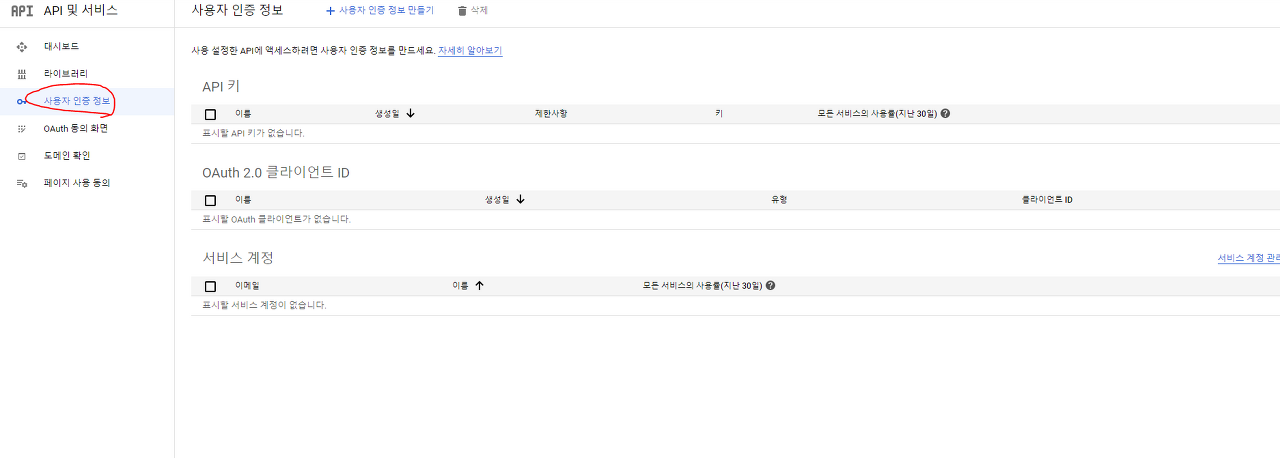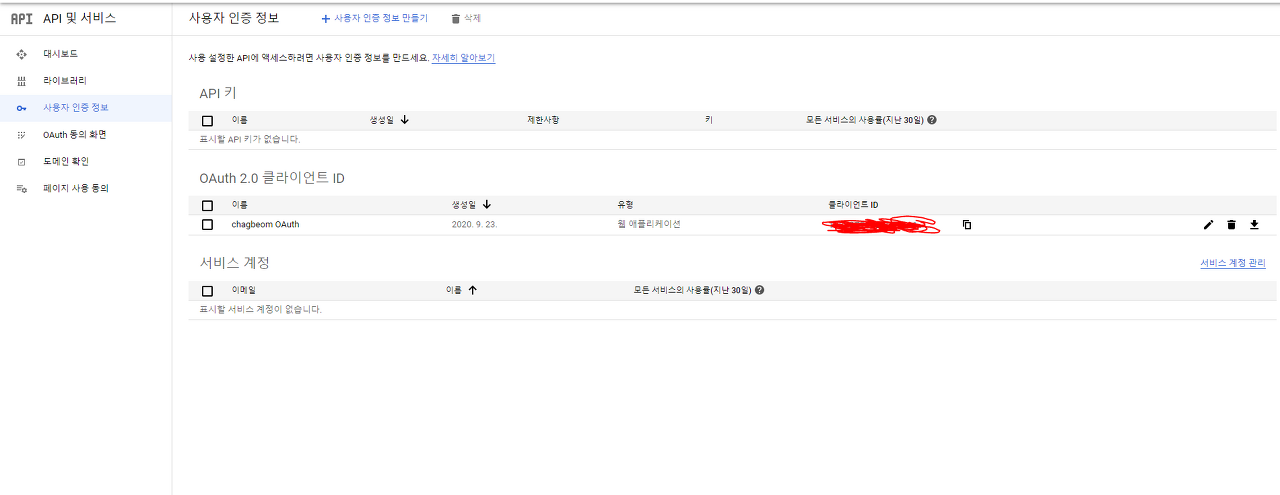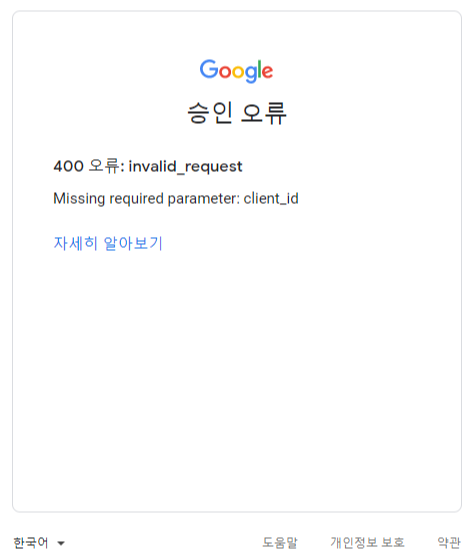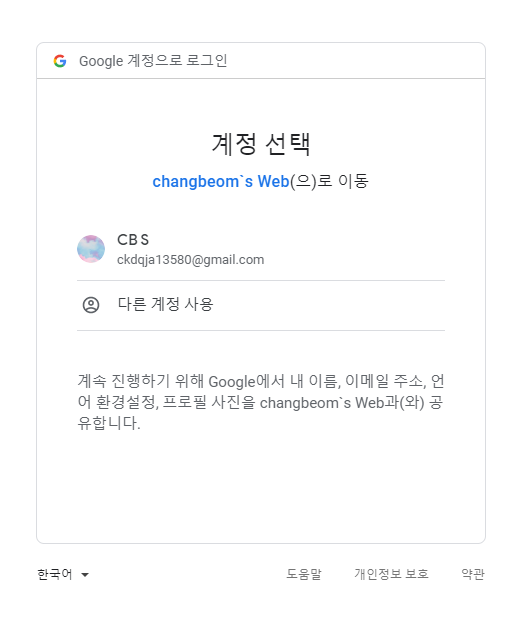OAuth?
자체 회원가입을 가지지 않고(또는 있음에도), 외부 유명한 사이트(구글, 페이스북, 등등)를 통해 계정의 정보를 가져오는것을 말합니다. 이것이 동작하는 구조는 클라이언트가 웹 사이트(A)에 로그인 요청을 하고, 그 사이트가 요청을 받으면 구글이나 페이스북 등에 OAuth를 요청하고, 그러면 클라이언트에게 해당 사이트(구글, 페이스북 등)의 로그인화면을 알려주게 되고, 클라이언트가 그 화면에서 로그인을 하고, 완료가 되면 콜백주소를 등록하게 되고, 그 해당 사이트(구글, 페이스북 등)가 클라이언트가 원래 로그인 하려고 했었던 사이트(A)에 콜백 주소를 통해 Refresh Key와 API Key를 알려주게 됩니다.
그리고 그 API Key를 통해 회원의 정보를 인가받게 됩니다.
근데 이 Key는 무한정 있는게 아니라서 Refresh Key를 통해서 재승인 받아야 됩니다.
그래서 이것을 개발하기 전에 구글, 네이버, 카카오, 페이스북 등에서 OAuth API와 Secret Key를 발급 받아야 합니다.
구글의 경우 여기에 들어가서 표시 되어있는 OAuth 동의 화면을 설정해 줍니다.

그러면 임의적인 애플리케이션이름을 지정해 주고, 맨 아래에 있는 저장 버튼을 눌러 줍니다.

특별한 권한을 요구하는 것을 설정하지 않았기 때문에 빠르게 승인이 되고, 그 후 사용자 인증 정보로 들어갑니다.

그 뒤 URL 칸에 http://localhost:3000을, 승인된 리디렉션 URL에는 http://localhost:3000/auth/google/callback을 넣어줍니다.

그 뒤 확인을 눌러주면 이렇게 정상적으로 등록 된 것을 알 수 있습니다.

그 뒤 발급받은 ID와 비밀번호는 환경변수에서 설정을 해주어야 합니다.

그 후 main.go 파일을 만들어 코딩을 시작해봅시다.!
package main
import "github.com/urfave/negroni"
func main() {
mux := pat.New() // 1
n := negroni.Classic() // 2
n.UseHandler(mux)
http.ListenAndServe(":3000", n)
}1 : pat라우터를 생성해주고,
2 : negroni로 pat라우터를 감싸 줍니다.
이렇게 기본적인 서버 구축이 완성 되었고, public/index.html를 만들어 작성해줍니다.
<html>
<head>
<title>Go Oauth2.0 Test</title>
</head>
<body>
<p><a href='./auth/google/login'>Google Login</a></p>
</body>
</html>그 후 서버를 실행해보면 구글 로그인 관련 하이퍼링크가 생겼고, 클릭해서 들어가면

관련 핸들러를 만들지 않았기 때문에 404Page가 뜨는 것을 확인 할 수 있습니다.

main.go로 돌아와 핸들러를 만들어 봅시다!
package main
import (
"github.com/gorilla/pat"
"github.com/urfave/negroni"
"golang.org/x/oauth2"
"golang.org/x/oauth2/google"
)
var googleOauthConfig = oauth2.Config{ // 2
RedirectURL: "http://localhost:3000/auth/google/callback", // 1
ClientID: os.Getenv("GOOGLE_CLIENT_ID"), // 2
ClientSecret: os.Getenv("GOOGLE_SECRET_KEY"), // 3
Scopes: []string{"https://www.googleapis.com/auth/userinfo.email"}, // 4
Endpoint: google.Endpoint, // 5
}
func googleLoginHandler(w http.ResponseWriter, r *http.Request) { // 3
state := generateStateOauthCookie(w) // 1
url := googleOauthConfig.AuthCodeURL(state) // 2
http.Redirect(w, r, url, http.StatusTemporaryRedirect) // 3
}
func generateStateOauthCookie(w http.ResponseWriter) string {
expiration := time.Now().Add(1 * 24 * time.Hour) // 4
b := make([]byte, 16) // 5
rand.Read(b) // 6
state := base64.URLEncoding.EncodeToString(b) // 7
cookie := &http.Cookie{Name: "oauthstate", Value: state, Expires: expiration} // 8
http.SetCookie(w, cookie) // 9
return state // 10
}1 : 구글 로그인 핸들러 입니다.
2 : 구글 OAuth를 지원해야 하기 때문에 googleOauthConfig를 만들어 줍니다.
이 때 터미널을 열어서go get golang.org/x/oauth2를 입력하여 패키지를 다운 받아 줍니다.
이어서 go get cloud.google.com/go로 패키지를 다운받아 줍니다.
이 두 패키지를 다운 받아야 OAuth를 사용할 수 있습니다.
2-1 : 리디렉션 URI을 입력해 줍니다.
2-2 : 발급받은 클라이언트 ID를 입력해주는데, 환경변수에 저장한 것을 가져오기 위해 os.Getenv()를 사용하고,
2-3 : 마찬가지로 Secret Key를 가져옵니다.
2-4 : 요청하는 data의 스코프인데 userinfo의 email에 접근하겠다는 권한을 의미합니다.
2-5 : 구글의 endpoint인데 이건 구글에 어떤 endpoint를 보낼건지 정의되어 있습니다.
3 : googleLoginHandler 함수. 구글 로그인을 요청받으면 googleOauthConfig를 통해 구글의 어떤 경로로 보내야 되는 지가 나오고, 유저가 그 경로로 접근해서 로그인 할 수 있도록 리다이렉트 시켜주면 됩니다.
3-1 : AuthCodeURL에 인자로 들어가는 state 입니다.
-> CSRF attacks인 URL 변조 공격을 막아주는 키가 됩니다.
그래서 리다이렉트로 콜백이 왔을 때 그 키가 맞는지 확인하기 위해 유저 브라우저 쿠키에 StatusTemporaryRedirect싣고,
Redirect로 콜백이 왔을 때 그 쿠키를 비교해보는 방식으로 작성했습니다.
3-2 : googleOauthConfig.AuthCodeURL가 유저를 어떤 경로로 보내야 하는지 URL코드를 보내줍니다.
3-3 : 보내게 되면 http.Redirect함수가 있는데 w, r을 쓰고 리다이렉트 하는 경로를 적어주고, 왜 리다이렉트하는지 코드를 알려주어야 합니다. 그렇게 해서 로그인이 완료되면 콜백URL을 구글에서 다시 알려 줍니다.
4 : 쿠키의 만료시간을 현재 시간으로 부터 하루로 설정합니다.
5 : 랜덤한 16byte 짜리 array를 만들어준다.
6 : 위의 b를 랜덤하게 채워주는 코드입니다.
7 : 그 다음 byte들을 HTML Encoding을 해주기 위한 코드 입니다.
EncodeToString로 소스를 집어 넣으면 string으로 바꾸어 줍니다.
8 : 이렇게 된 것을 쿠키에 집어 넣어주는데, 그러기 위해 쿠키struct를 만들어 줍니다.
쿠키struct는 Name, Value, Path, Domain, Expires, RawExpires값이 들어가는 데 Name, Value는 필수고 나머지는 옵션값 입니다.
지금은 Name, Value, Expries값을 넣어 줍니다.
9 : write에 지금 만든 쿠키를 넣어주고,
10 : string을 리턴해야 하기 때문에 state값을 리턴 해줍니다.
func googleAuthCallback(w http.ResponseWriter, r *http.Request) {
oauthstate, _ := r.Cookie("oauthstate") // 12
if r.FormValue("state") != oauthstate.Value { // 13
log.Printf("invalid google oauth state cookie:%s state:%s\n", oauthstate.Value, r.FormValue("state"))
http.Redirect(w, r, "/", http.StatusTemporaryRedirect)
return
}
data, err := getGoogleUserInfo(r.FormValue("code")) // 14
if err != nil { // 15
log.Println(err.Error())
http.Redirect(w, r, "/", http.StatusTemporaryRedirect)
return
}
fmt.Fprint(w, string(data)) // 16
}11 : 구글 콜백 핸들러 입니다.
12 : 이 핸들러가 불리면 아까 저장했던 쿠키를 읽어오고,
13 : request값에 state값을 넣어주기 위해 FormValue()를 사용합니다.
oauthstate의 값과 FormValue()의 값이 다르면 Redirect시켜 줍니다.
여기서 에러를 반환하면 해커가 무엇이 문제인지 단서를 제공하는 것이 되므로 바로 기본경로로 Redirect시켜준다.
그리고 공격시도가 있었기 때문에 log를 남겨줍니다.
14 : 구글이 Request에 코드를 알려주는데 그 코드를 가지고 구글에 다시 요청을 해서 userinfo를 가져올 수 있습니다.
15 : 에러가 있을 시 에러처리 후 Redirect시켜 줍니다.
16 : 에러가 없을 시 유저의 정보를 보냅니다.
const oauthGoogleUrlAPI = "https://www.googleapis.com/oauth2/v2/userinfo?access_token=" // 21
func getGoogleUserInfo(code string) ([]byte, error) { // 17
token, err := googleOauthConfig.Exchange(context.Background(), code) // 18
if err != nil { // 19
return nil, fmt.Errorf("Failed to Exchange %s\n", err.Error())
}
resp, err := http.Get(oauthGoogleUrlAPI + token.AccessToken) // 20
if err != nil { // 21
return nil, fmt.Errorf("Failed to Get UserInfo %s\n", err.Error())
}
return ioutil.ReadAll(resp.Body) // 23
}
func main() {
mux := pat.New()
mux.HandleFunc("/auth/google/login", googleLoginHandler) // 1
mux.HandleFunc("/auth/google/callback", googleAuthCallback) // 11
n := negroni.Classic()
n.UseHandler(mux)
http.ListenAndServe(":3000", n)
}17 : 14번의 함수를 작성 합니다. code가 오게되고 반환값은 data와 error가 됩니다.
18 : googleOauthConfig을 이용해서 tokken을 받아오는 코드인데,
받은 code와 tokken을 Exchange()(교환)합니다. 이 때 Exchange할 때 들어가는 인자가 context값과 code값이 들어가는데,
context값은 쓰레드간에 어떤 데이터를 주고받을 때 사용되는 저장소 라고 생각하면 됩니다.
여기서는 간단하게 기본 context인 context.Background()를 사용해 줍니다.
이 함수는 tokken과 error를 반환하게 됩니다.
19 : 에러 발생 시 처리.
문자열로 에러를 만들어 주고, 받은값이 없으므로 nil을 반환해 줍니다.
20 : tokken이 온 상태 이므로 그 tokken 가지고 userinfo를 request해야 합니다.
21번 URL 맨 뒤쪽에 access_tokken 부분에 access_tokken인자를 넣어주면 구글에서 리턴값으로 userinfo를 알려주게 됩니다.
Token struct를 보게 되면 AccessToken이 있고, RefreshToken이 있습니다.
AccessToken은 구글에 정보를 요청할 때 사용되는 토큰이고, 이 토큰이 만료 될 때 RefreshToken으로 다시 AccessToken을 받아야 하는데 한번만 유저정보를 요청 할 것이므로 Access Token을 쓰면 됩니다. 그래서 저 경로에 Access Token을 붙여서 http.Get으로 요청하면 됩니다. 그렇게 할 때 response와 erorr가 나오게 됩니다.
21 : userinfo를 request하는 경로.
22 : (20번 이어서) 19번과 마찬가지로 처리 해주고,
23 : error가 없다면 resp의 데이터를 읽어오면 되는데, resp.Body를 모두 읽어서 data를 반환 해줍니다.
이제 저장 후 실행을 시켜봅시다!
혹시나 실행 시 아래와 같은 창이 뜬다면

var googleOauthConfig = oauth2.Config{
RedirectURL: "http://localhost:3000/auth/google/callback",
ClientID: os.Getenv("GOOGLE_CLIENT_ID"),
ClientSecret: os.Getenv("GOOGLE_SECRET_KEY"),
Scopes: []string{"https://www.googleapis.com/auth/userinfo.email"},
Endpoint: google.Endpoint,
}
이 부분에서 ClientID와 ClientSecret값을 직접 넣어주면 해결됩니다.
구글 로그인 링크로 접속 후

로그인을 하게 되면

아래와 같이 그 유저의 정보가 뜨게 됩니다.

풀소스
main.go
package main
import (
"context"
"crypto/rand"
"encoding/base64"
"fmt"
"io/ioutil"
"log"
"net/http"
"os"
"time"
"github.com/gorilla/pat"
"github.com/urfave/negroni"
"golang.org/x/oauth2"
"golang.org/x/oauth2/google"
)
var googleOauthConfig = oauth2.Config{
RedirectURL: "http://localhost:3000/auth/google/callback",
ClientID: os.Getenv("GOOGLE_CLIENT_ID"),
ClientSecret: os.Getenv("GOOGLE_SECRET_KEY"),
Scopes: []string{"https://www.googleapis.com/auth/userinfo.email"},
Endpoint: google.Endpoint,
}
func googleLoginHandler(w http.ResponseWriter, r *http.Request) {
state := generateStateOauthCookie(w)
url := googleOauthConfig.AuthCodeURL(state)
http.Redirect(w, r, url, http.StatusTemporaryRedirect)
}
func generateStateOauthCookie(w http.ResponseWriter) string {
expiration := time.Now().Add(1 * 24 * time.Hour)
b := make([]byte, 16)
rand.Read(b)
state := base64.URLEncoding.EncodeToString(b)
cookie := &http.Cookie{Name: "oauthstate", Value: state, Expires: expiration}
http.SetCookie(w, cookie)
return state
}
func googleAuthCallback(w http.ResponseWriter, r *http.Request) {
oauthstate, _ := r.Cookie("oauthstate")
if r.FormValue("state") != oauthstate.Value {
log.Printf("invalid google oauth state cookie:%s state:%s\n", oauthstate.Value, r.FormValue("state"))
http.Redirect(w, r, "/", http.StatusTemporaryRedirect)
return
}
data, err := getGoogleUserInfo(r.FormValue("code"))
if err != nil {
log.Println(err.Error())
http.Redirect(w, r, "/", http.StatusTemporaryRedirect)
return
}
fmt.Fprint(w, string(data))
}
const oauthGoogleUrlAPI = "https://www.googleapis.com/oauth2/v2/userinfo?access_token="
func getGoogleUserInfo(code string) ([]byte, error) {
token, err := googleOauthConfig.Exchange(context.Background(), code)
if err != nil {
return nil, fmt.Errorf("Failed to Exchange %s\n", err.Error())
}
resp, err := http.Get(oauthGoogleUrlAPI + token.AccessToken)
if err != nil {
return nil, fmt.Errorf("Failed to Get UserInfo %s\n", err.Error())
}
return ioutil.ReadAll(resp.Body)
}
func main() {
mux := pat.New()
mux.HandleFunc("/auth/google/login", googleLoginHandler)
mux.HandleFunc("/auth/google/callback", googleAuthCallback)
n := negroni.Classic()
n.UseHandler(mux)
http.ListenAndServe(":3000", n)
}
public/index.html
<html>
<head>
<title>Go Oauth2.0 Test</title>
</head>
<body>
<p><a href='./auth/google/login'>Google Login</a></p>
</body>
</html>
'프로그래밍(Web) > Golang' 카테고리의 다른 글
| [바미] Go - Refactoring (0) | 2020.12.17 |
|---|---|
| [바미] Go - Todo(Add, Delete, Complete) (0) | 2020.12.17 |
| [바미] Go - Template (0) | 2020.12.17 |
| [바미] Go - SQL query(CRUD) (0) | 2020.12.17 |
| [바미] Go - Render, Pat, Negroni (0) | 2020.12.17 |